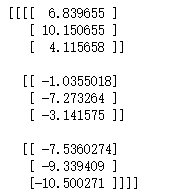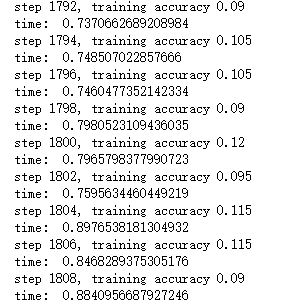import struct import numpy as np import matplotlib.pyplot as plt dateMat = np.ones((7,7)) kernel = np.array([[2,1,1],[3,0,1],[1,1,0]]) def convolve(dateMat,kernel): m,n = dateMat.shape km,kn = kernel.shape newMat = np.ones(((m - km + 1),(n - kn + 1))) tempMat = np.ones(((km),(kn))) for row in range(m - km + 1): for col in range(n - kn + 1): for m_k in range(km): for n_k in range(kn): tempMat[m_k,n_k] = dateMat[(row + m_k),(col + n_k)] * kernel[m_k,n_k] newMat[row,col] = np.sum(tempMat) return newMat newMat = convolve(dateMat,kernel) print(newMat)

import tensorflow as tf input1 = tf.Variable(tf.random_normal([1, 3, 3, 1])) filter1 = tf.Variable(tf.ones([1, 1, 1, 1])) init = tf.global_variables_initializer() with tf.Session() as sess: sess.run(init) conv2d = tf.nn.conv2d(input1, filter1, strides=[1, 1, 1, 1], padding='VALID') print(sess.run(conv2d))

import tensorflow as tf input1 = tf.Variable(tf.random_normal([1, 5, 5, 5])) filter1 = tf.Variable(tf.ones([3, 3, 5, 1])) init = tf.global_variables_initializer() with tf.Session() as sess: sess.run(init) conv2d = tf.nn.conv2d(input1, filter1, strides=[1, 1, 1, 1], padding='VALID') print(sess.run(conv2d))

import tensorflow as tf input1 = tf.Variable(tf.random_normal([1, 5, 5, 5])) filter1 = tf.Variable(tf.ones([3, 3, 5, 1])) init = tf.global_variables_initializer() with tf.Session() as sess: sess.run(init) conv2d = tf.nn.conv2d(input1, filter1, strides=[1, 1, 1, 1], padding='SAME') print(sess.run(conv2d))

import tensorflow as tf input1 = tf.Variable(tf.random_normal([1, 5, 5, 5])) filter1 = tf.Variable(tf.ones([3, 3, 5, 1])) init = tf.global_variables_initializer() with tf.Session() as sess: sess.run(init) conv2d = tf.nn.conv2d(input1, filter1, strides=[1, 2, 2, 1], padding='SAME') print(sess.run(conv2d))

import cv2 import numpy as np import tensorflow as tf img = cv2.imread("D:\F\TensorFlow_deep_learn\data\lena.jpg") img = np.array(img,dtype=np.float32) x_image=tf.reshape(img,[1,512,512,3]) filter1 = tf.Variable(tf.ones([7, 7, 3, 1])) init = tf.global_variables_initializer() with tf.Session() as sess: sess.run(init) res = tf.nn.conv2d(x_image, filter1, strides=[1, 2, 2, 1], padding='SAME') res_image = sess.run(tf.reshape(res,[256,256]))/128 + 1 cv2.imshow("lover",res_image.astype('uint8')) cv2.waitKey()
import cv2 import numpy as np import tensorflow as tf img = cv2.imread("D:\F\TensorFlow_deep_learn\data\lena.jpg") img = np.array(img,dtype=np.float32) x_image=tf.reshape(img,[1,512,512,3]) filter1 = tf.Variable(tf.ones([11, 11, 3, 1])) init = tf.global_variables_initializer() with tf.Session() as sess: sess.run(init) res = tf.nn.conv2d(x_image, filter1, strides=[1, 2, 2, 1], padding='SAME') res_image = sess.run(tf.reshape(res,[256,256]))/128 + 1 cv2.imshow("lover",res_image.astype('uint8')) cv2.waitKey()
import tensorflow as tf data=tf.constant([ [[3.0,2.0,3.0,4.0], [2.0,6.0,2.0,4.0], [1.0,2.0,1.0,5.0], [4.0,3.0,2.0,1.0]] ]) data = tf.reshape(data,[1,4,4,1]) maxPooling=tf.nn.max_pool(data, [1, 2, 2, 1], [1, 2, 2, 1], padding='VALID') with tf.Session() as sess: print(sess.run(maxPooling))

import cv2 import numpy as np import tensorflow as tf img = cv2.imread("D:\F\TensorFlow_deep_learn\data\lena.jpg") img = np.array(img,dtype=np.float32) x_image=tf.reshape(img,[1,512,512,3]) filter1 = tf.Variable(tf.ones([7, 7, 3, 1])) init = tf.global_variables_initializer() with tf.Session() as sess: sess.run(init) res = tf.nn.conv2d(x_image, filter1, strides=[1, 2, 2, 1], padding='SAME') res = tf.nn.max_pool(res, [1, 2, 2, 1], [1, 2, 2, 1], padding='VALID') res_image = sess.run(tf.reshape(res,[128,128]))/128 + 1 cv2.imshow("lover",res_image.astype('uint8')) cv2.waitKey()
import time import tensorflow as tf from tensorflow.examples.tutorials.mnist import input_data # 声明输入图片数据,类别 x = tf.placeholder('float', [None, 784]) y_ = tf.placeholder('float', [None, 10]) # 输入图片数据转化 x_image = tf.reshape(x, [-1, 28, 28, 1]) #第一层卷积层,初始化卷积核参数、偏置值,该卷积层5*5大小,一个通道,共有6个不同卷积核 filter1 = tf.Variable(tf.truncated_normal([5, 5, 1, 6])) bias1 = tf.Variable(tf.truncated_normal([6])) conv1 = tf.nn.conv2d(x_image, filter1, strides=[1, 1, 1, 1], padding='SAME') h_conv1 = tf.nn.sigmoid(conv1 + bias1) maxPool2 = tf.nn.max_pool(h_conv1, ksize=[1, 2, 2, 1],strides=[1, 2, 2, 1], padding='SAME') filter2 = tf.Variable(tf.truncated_normal([5, 5, 6, 16])) bias2 = tf.Variable(tf.truncated_normal([16])) conv2 = tf.nn.conv2d(maxPool2, filter2, strides=[1, 1, 1, 1], padding='SAME') h_conv2 = tf.nn.sigmoid(conv2 + bias2) maxPool3 = tf.nn.max_pool(h_conv2, ksize=[1, 2, 2, 1],strides=[1, 2, 2, 1], padding='SAME') filter3 = tf.Variable(tf.truncated_normal([5, 5, 16, 120])) bias3 = tf.Variable(tf.truncated_normal([120])) conv3 = tf.nn.conv2d(maxPool3, filter3, strides=[1, 1, 1, 1], padding='SAME') h_conv3 = tf.nn.sigmoid(conv3 + bias3) # 全连接层 # 权值参数 W_fc1 = tf.Variable(tf.truncated_normal([7 * 7 * 120, 80])) # 偏置值 b_fc1 = tf.Variable(tf.truncated_normal([80])) # 将卷积的产出展开 h_pool2_flat = tf.reshape(h_conv3, [-1, 7 * 7 * 120]) # 神经网络计算,并添加sigmoid激活函数 h_fc1 = tf.nn.sigmoid(tf.matmul(h_pool2_flat, W_fc1) + b_fc1) # 输出层,使用softmax进行多分类 W_fc2 = tf.Variable(tf.truncated_normal([80, 10])) b_fc2 = tf.Variable(tf.truncated_normal([10])) y_conv = tf.nn.softmax(tf.matmul(h_fc1, W_fc2) + b_fc2) # 损失函数 cross_entropy = -tf.reduce_sum(y_ * tf.log(y_conv)) # 使用GDO优化算法来调整参数 train_step = tf.train.GradientDescentOptimizer(0.001).minimize(cross_entropy) sess = tf.InteractiveSession() # 测试正确率 correct_prediction = tf.equal(tf.argmax(y_conv, 1), tf.argmax(y_, 1)) accuracy = tf.reduce_mean(tf.cast(correct_prediction, "float")) # 所有变量进行初始化 sess.run(tf.initialize_all_variables()) # 获取mnist数据 mnist_data_set = input_data.read_data_sets("D:\F\TensorFlow_deep_learn\MNIST\", one_hot=True) # 进行训练 start_time = time.time() for i in range(20000): # 获取训练数据 batch_xs, batch_ys = mnist_data_set.train.next_batch(200) # 每迭代100个 batch,对当前训练数据进行测试,输出当前预测准确率 if i % 2 == 0: train_accuracy = accuracy.eval(feed_dict={x: batch_xs, y_: batch_ys}) print("step %d, training accuracy %g" % (i, train_accuracy)) # 计算间隔时间 end_time = time.time() print('time: ', (end_time - start_time)) start_time = end_time # 训练数据 train_step.run(feed_dict={x: batch_xs, y_: batch_ys}) # 关闭会话 sess.close()

import time import tensorflow as tf from tensorflow.examples.tutorials.mnist import input_data # 声明输入图片数据,类别 x = tf.placeholder('float', [None, 784]) y_ = tf.placeholder('float', [None, 10]) # 输入图片数据转化 x_image = tf.reshape(x, [-1, 28, 28, 1]) #第一层卷积层,初始化卷积核参数、偏置值,该卷积层5*5大小,一个通道,共有6个不同卷积核 filter1 = tf.Variable(tf.truncated_normal([5, 5, 1, 6])) bias1 = tf.Variable(tf.truncated_normal([6])) conv1 = tf.nn.conv2d(x_image, filter1, strides=[1, 1, 1, 1], padding='SAME') h_conv1 = tf.nn.relu(conv1 + bias1) maxPool2 = tf.nn.max_pool(h_conv1, ksize=[1, 2, 2, 1],strides=[1, 2, 2, 1], padding='SAME') filter2 = tf.Variable(tf.truncated_normal([5, 5, 6, 16])) bias2 = tf.Variable(tf.truncated_normal([16])) conv2 = tf.nn.conv2d(maxPool2, filter2, strides=[1, 1, 1, 1], padding='SAME') h_conv2 = tf.nn.relu(conv2 + bias2) maxPool3 = tf.nn.max_pool(h_conv2, ksize=[1, 2, 2, 1],strides=[1, 2, 2, 1], padding='SAME') filter3 = tf.Variable(tf.truncated_normal([5, 5, 16, 120])) bias3 = tf.Variable(tf.truncated_normal([120])) conv3 = tf.nn.conv2d(maxPool3, filter3, strides=[1, 1, 1, 1], padding='SAME') h_conv3 = tf.nn.relu(conv3 + bias3) # 全连接层 # 权值参数 W_fc1 = tf.Variable(tf.truncated_normal([7 * 7 * 120, 80])) # 偏置值 b_fc1 = tf.Variable(tf.truncated_normal([80])) # 将卷积的产出展开 h_pool2_flat = tf.reshape(h_conv3, [-1, 7 * 7 * 120]) # 神经网络计算,并添加relu激活函数 h_fc1 = tf.nn.relu(tf.matmul(h_pool2_flat, W_fc1) + b_fc1) # 输出层,使用softmax进行多分类 W_fc2 = tf.Variable(tf.truncated_normal([80, 10])) b_fc2 = tf.Variable(tf.truncated_normal([10])) y_conv = tf.nn.softmax(tf.matmul(h_fc1, W_fc2) + b_fc2) # 损失函数 cross_entropy = -tf.reduce_sum(y_ * tf.log(y_conv)) # 使用GDO优化算法来调整参数 train_step = tf.train.GradientDescentOptimizer(0.001).minimize(cross_entropy) sess = tf.InteractiveSession() # 测试正确率 correct_prediction = tf.equal(tf.argmax(y_conv, 1), tf.argmax(y_, 1)) accuracy = tf.reduce_mean(tf.cast(correct_prediction, "float")) # 所有变量进行初始化 sess.run(tf.initialize_all_variables()) # 获取mnist数据 mnist_data_set = input_data.read_data_sets("D:\F\TensorFlow_deep_learn\MNIST\", one_hot=True) # 进行训练 start_time = time.time() for i in range(20000): # 获取训练数据 batch_xs, batch_ys = mnist_data_set.train.next_batch(200) # 每迭代100个 batch,对当前训练数据进行测试,输出当前预测准确率 if i % 2 == 0: train_accuracy = accuracy.eval(feed_dict={x: batch_xs, y_: batch_ys}) print("step %d, training accuracy %g" % (i, train_accuracy)) # 计算间隔时间 end_time = time.time() print('time: ', (end_time - start_time)) start_time = end_time # 训练数据 train_step.run(feed_dict={x: batch_xs, y_: batch_ys}) # 关闭会话 sess.close()
